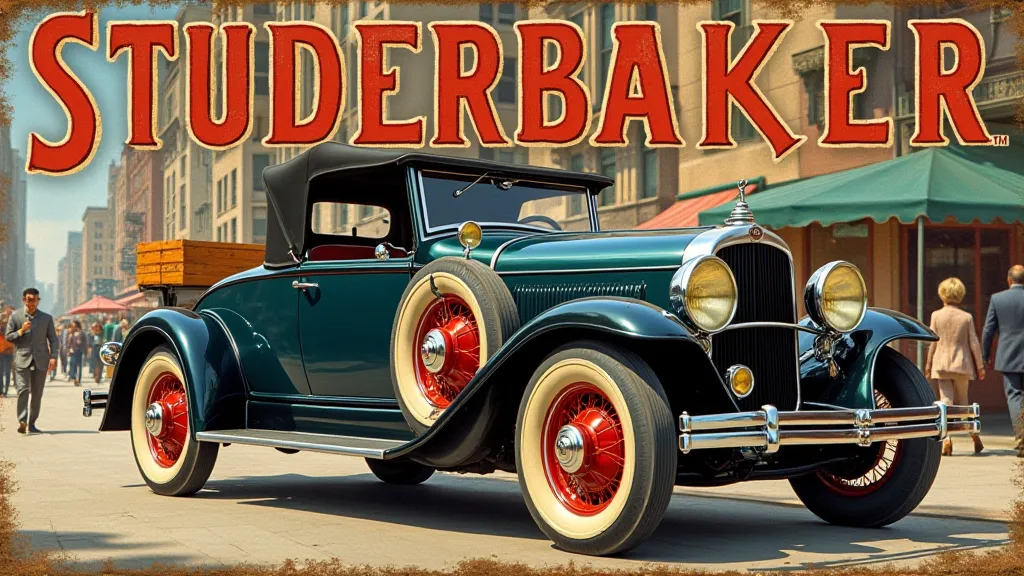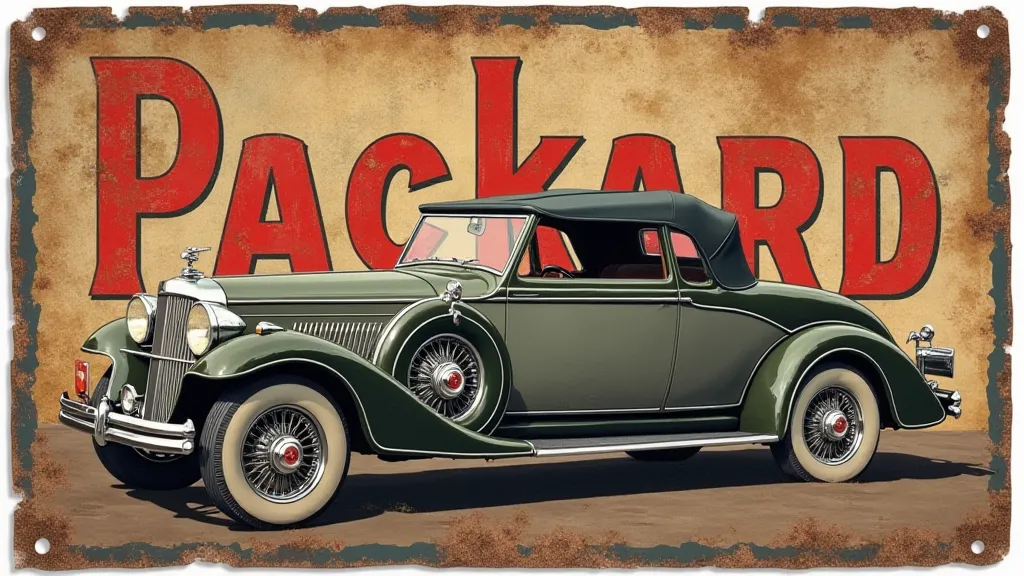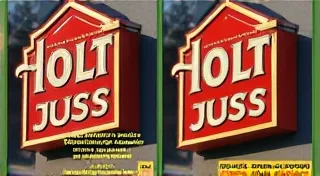The Golden Age of Automotive Advertising Signs
The early 1900s witnessed a remarkable transformation – the rise of the automobile. What began as a luxury for the wealthy quickly evolved into a symbol of progress and a burgeoning industry. This period, often referred to as the “Golden Age” of automobiles, also spurred an equally vibrant era of advertising, most notably in the form of captivating and collectible advertising signs. These signs weren't merely functional; they were works of art designed to entice potential buyers and establish brand recognition in a competitive market.
A Landscape of Innovation & Competition
The automobile industry in its infancy was characterized by intense competition. Numerous manufacturers, each striving for dominance, flooded the market with new models. This scramble for market share fueled an unprecedented level of advertising, and these manufacturers understood the power of visual appeal. Unlike today's digital landscape, advertising relied heavily on printed materials and, crucially, large, eye-catching signs placed strategically in public spaces. These signs became part of the visual culture of the time, and many remain highly sought-after by collectors today. The sheer volume of signs created is staggering, and understanding the context of their creation – the fierce competition for customers – is key to appreciating their historical significance. The beauty of these now-faded relics, and their own peculiar charm, is truly something to behold, reminding us of a time when bold graphics and enduring messages reigned supreme. One might even consider the subtle subversiveness of these signs, imbued as they are with the spirit of a bygone era - a topic explored in greater detail in articles like "Chromatic Ghosts: The Subversive Beauty of Faded Signage".

Iconic Brands & Design Styles
Names like Ford, Dodge, Studebaker, Packard, and Chevrolet became household words, largely thanks to the relentless advertising campaigns of the era. The signs themselves were diverse, reflecting the artistic styles prevalent at the time. You're likely to find:
- Porcelain Enamel Signs: Durable and weather-resistant, these were commonly used for outdoor display. The vibrant colors and detailed graphics make them particularly desirable to collectors. Their durability stemmed from a careful and complex manufacturing process, making them relatively rare today. Understanding the history of these resilient signs, and the manufacturing techniques employed, is a fascinating deep dive - learn more about "The History of Porcelain Enamel Signs: A Durable Advertising Legacy".
- Lithographed Cardboard Signs: Often more decorative and visually striking, these were often used in dealerships and service stations. While beautiful, the fragility of these signs presents unique challenges for preservation, a topic explored in more detail in articles dedicated to paper signs.
- Metal Signs (Steel & Tin): Strong and relatively inexpensive, these signs were often used for a more rugged, industrial aesthetic. The rust and deterioration common to these signs can significantly impact their value, and restoration requires specialized knowledge.
Design motifs frequently incorporated patriotic imagery, depictions of prosperous families enjoying the freedom of the open road, and artistic representations of the cars themselves. Bold typography and clever slogans were also key components of effective advertising. The artistry extended beyond mere aesthetics; the goal was to create an emotional connection with the potential buyer, a nuanced aspect often overlooked by casual observers.
Popular Themes and Imagery
Several recurring themes and images were used to appeal to potential buyers. These often highlighted:
- Reliability & Durability: Ads emphasized the car's ability to handle rough terrain and long distances. This was particularly important in an era where roads were often unpaved and unpredictable.
- Performance & Speed: Manufacturers aimed to portray their vehicles as fast and powerful, promising a thrilling driving experience. Speed wasn't just about getting from point A to point B; it was a symbol of progress and modernity.
- Style & Status: Owning a car was often presented as a symbol of success and sophistication, a tangible representation of upward mobility.
- Family & Adventure: Many signs depicted families embarking on road trips, associating the car with fun and excitement – and selling the dream of the open road. The evolution of the family automobile, and its role in shaping American culture, is a fascinating subject in itself.

The Business of Advertising & Collector Considerations
The companies that produced these signs – and the advertising agencies they employed – were innovators in their own right. They understood the power of repetition, the importance of branding, and the psychology of persuasion. For collectors, this historical context is invaluable. Determining the true value of a vintage advertising sign involves more than just examining its physical condition; it requires understanding its rarity, its historical significance, and the demand among collectors. However, these reproductions are becoming increasingly prevalent, making authentication crucial. "The Art of Reproduction Signs: Spotting the Fakes" provides valuable insights into identifying genuine artifacts.
For those looking to begin or expand a collection, navigating the world of vintage advertising signs can be daunting. Knowing where to find authentic pieces, assessing their condition, and negotiating fair prices are crucial skills. Furthermore, the ethical considerations of buying and selling these pieces – ensuring authenticity and avoiding misrepresentation – are paramount. Resources and guidance can be found from various sources, including online forums and established dealers. Learning the etiquette surrounding buying, selling, and trading vintage signs is also crucial and can be a complex subject; further information can be found at sign collecting etiquette guides.
Preserving the Artwork: Cleaning & Restoration
Many vintage signs are found in a state of disrepair, often bearing the marks of decades of exposure to the elements. While some collectors prefer to preserve these signs in their original, weathered condition, others undertake the delicate process of cleaning and restoration. However, improper techniques can easily damage a sign, decreasing its value and potentially destroying its historical integrity. The best approach depends on the type of sign, its condition, and the collector’s goals. This often involves a delicate balance between preserving patina and removing surface damage – a challenge that demands expertise. The process is highly specialized, and those interested in attempting restoration should consult with experienced professionals. The subtle art of cleaning and restoring these signs requires a deep understanding of the materials and techniques involved.
Rarity and Value Factors
For collectors of vintage advertising signs, the Golden Age of Automotive Advertising represents a particularly rich and rewarding area of interest. Several factors influence the value of these signs:
- Rarity: Signs from lesser-known manufacturers or those with unique design features are generally more valuable. The more obscure the brand, the greater the challenge in finding information and verifying authenticity.
- Condition: Signs in excellent condition, free from significant rust, damage, or fading, command a premium. Even minor imperfections can significantly impact value.
- Size & Material: Larger signs and those made from desirable materials (like porcelain enamel) are often sought after. The cost of materials and the complexity of manufacturing also contribute to value.
- Graphics & Design: Signs with visually appealing and historically significant designs are highly prized. Artwork that reflects the artistic trends of the era contributes to collectibility.
- Regional Significance: Signs advertising brands or dealerships that were important in a specific region can also hold significant value to local collectors.
- Display Potential: Signs that are visually appealing and easy to display tend to fetch higher prices, especially those that complement contemporary decor.
- Provenance: The documented history of a sign, including previous ownership and exhibition records, can significantly increase its value.

Protecting Your Investment: Storage and Display Tips
Once acquired, vintage advertising signs require careful handling and storage to maintain their value. Proper storage involves protecting them from direct sunlight, extreme temperatures, and humidity. Displaying these treasures is an art in itself, requiring secure mounting and appropriate lighting to highlight their unique features. "Protecting Your Investment: Storage and Display Tips" delves deeper into these vital considerations.
Preserving Automotive History
Vintage automotive advertising signs are more than just collectibles; they are tangible links to a bygone era. They provide invaluable insights into the history of the automotive industry, advertising techniques, and consumer culture. By preserving and appreciating these relics, we safeguard a vital part of our cultural heritage. The captivating allure of these signs continues to resonate with collectors and enthusiasts worldwide, ensuring their enduring legacy for generations to come.
The fascination with these vintage advertising signs extends far beyond their monetary value. They offer a unique window into the past, revealing the hopes, dreams, and aspirations of a generation. By appreciating these tangible pieces of history, we enrich our understanding of the cultural forces that shaped our world.
Conclusion
The Golden Age of Automotive Advertising Signs remains a captivating chapter in American history, rich with innovation, artistry, and nostalgia. These iconic signs serve as enduring reminders of a time when the automobile was not merely a mode of transportation, but a symbol of progress, freedom, and the American dream. As collectors and enthusiasts continue to cherish and preserve these treasures, their legacy will endure for generations to come.





